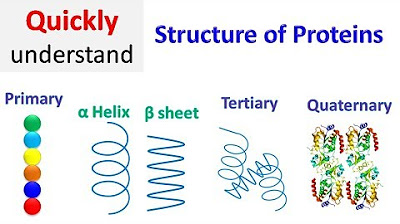Asam Amino & Protein Part 5: Pembentukan Ikatan Peptida
Summary
TLDRThis video explains the concept of peptide bonds, which are essential for protein formation. It demonstrates how two amino acids are linked via a peptide bond, releasing water as a byproduct. The video covers how dipeptides, tripeptides, and longer polypeptide chains form through this process. Using examples like alanine and serine, the script illustrates the bonding mechanism and emphasizes the importance of visualizing the process to enhance understanding. The ultimate goal is to understand how peptide bonds lead to the creation of proteins, the building blocks of life.
Takeaways
- 😀 Peptide bonds are the connections that link amino acids together to form peptides and proteins.
- 😀 The process of forming a peptide bond involves the release of water (H2O).
- 😀 A single peptide bond links two amino acids, while multiple peptide bonds create longer chains like tripeptides, polypeptides, and eventually proteins.
- 😀 Peptide bonds are formed through a natural reaction where the amino group (NH2) of one amino acid binds with the carboxyl group (COOH) of another.
- 😀 The formation of a peptide bond results in the removal of a water molecule, which is crucial in linking amino acids.
- 😀 A dipeptide is formed when two amino acids join through a peptide bond, and this process continues as more amino acids are added.
- 😀 The sequence of amino acids and the type of peptide bonds formed determine the structure and function of proteins.
- 😀 The speaker uses an example with alanine and serine amino acids to explain how peptide bonds are formed.
- 😀 The video highlights the significance of peptide bonds in creating functional proteins from smaller amino acid units.
- 😀 Peptide bonds are essential in the biological process of forming proteins, which are large and complex molecules crucial for various life functions.
- 😀 The creation of proteins involves the linking of many peptide bonds, and once there are over ten peptide bonds, a polypeptide chain is formed, which eventually folds into a functional protein.
Q & A
What is a peptide bond?
-A peptide bond is the bond that links two amino acids together, formed when the amino group of one amino acid reacts with the carboxyl group of another, releasing a molecule of water.
What happens when a protein is broken down into smaller units?
-When a protein is broken down, it gets cut into peptides, and further cutting results in individual amino acids.
What is the role of a peptide bond in protein formation?
-Peptide bonds are essential in protein formation as they link amino acids together, forming polypeptides, which ultimately fold into functional proteins.
What occurs during the formation of a peptide bond?
-During the formation of a peptide bond, the amino group of one amino acid reacts with the carboxyl group of another amino acid, releasing a water molecule, and the carbon atom of one amino acid binds to the nitrogen atom of the other.
What happens when two amino acids form a peptide bond?
-When two amino acids form a peptide bond, they create a dipeptide, which is the simplest peptide consisting of two linked amino acids.
How does the process of peptide bond formation occur in nature?
-The formation of a peptide bond occurs naturally when the amino group of one amino acid interacts with the carboxyl group of another, resulting in a bond with the release of water (H2O).
Can you explain the visual representation of peptide bond formation?
-In the visual representation, two amino acids are shown close together. The hydroxyl group from the carboxyl group of one amino acid reacts with the hydrogen from the amino group of another amino acid, releasing a molecule of water, and the remaining atoms form a peptide bond.
What is the difference between dipeptides and tripeptides?
-A dipeptide consists of two amino acids linked by one peptide bond, while a tripeptide contains three amino acids linked by two peptide bonds.
What happens when multiple peptide bonds form?
-When multiple peptide bonds form, they create a polypeptide chain, which, depending on its size and structure, can fold into a functional protein.
How are peptide bonds significant in biochemistry?
-Peptide bonds are fundamental in biochemistry as they form the backbone of proteins, allowing for the structure and function of enzymes, antibodies, and many other essential biological molecules.
Outlines

Dieser Bereich ist nur für Premium-Benutzer verfügbar. Bitte führen Sie ein Upgrade durch, um auf diesen Abschnitt zuzugreifen.
Upgrade durchführenMindmap

Dieser Bereich ist nur für Premium-Benutzer verfügbar. Bitte führen Sie ein Upgrade durch, um auf diesen Abschnitt zuzugreifen.
Upgrade durchführenKeywords

Dieser Bereich ist nur für Premium-Benutzer verfügbar. Bitte führen Sie ein Upgrade durch, um auf diesen Abschnitt zuzugreifen.
Upgrade durchführenHighlights

Dieser Bereich ist nur für Premium-Benutzer verfügbar. Bitte führen Sie ein Upgrade durch, um auf diesen Abschnitt zuzugreifen.
Upgrade durchführenTranscripts

Dieser Bereich ist nur für Premium-Benutzer verfügbar. Bitte führen Sie ein Upgrade durch, um auf diesen Abschnitt zuzugreifen.
Upgrade durchführen5.0 / 5 (0 votes)






